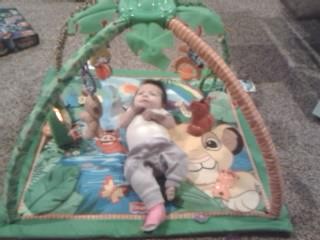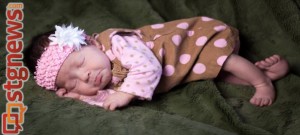
IVINS – Local mom Ashley Kelton is struggling to support and treat her 8-month-old daughter Kenzlie’s clubfoot to give her an opportunity for a healthy life.

In her first year, Kenzlie has already been plagued by hardships. Born on Oct. 22, 2012, she suffered from a lung infection, heart murmur and clubfoot deformity in her right foot, and spent nine days in the neonatal intensive care unit at Dixie Regional Medical Center. At just two weeks old, Kenzlie’s right foot was placed in a corrective cast, the first in a lengthy series of treatments attempting to heal her condition.
For the next eight weeks, her cast was replaced once a week to continue manipulating the foot. A tendon release, a surgical procedure in which a tendon is clipped in order to decrease tension in the muscle it controls, was performed on her Achilles tendon. Then she was put into a brace intended to remain on her leg for three months.
However, two weeks after the placing of the brace, Kelton received the unfortunate news that her daughter would need another tendon release and five more weeks of casting. Months passed, alternating between the cast and brace, with no success. Then Kelton consulted a surgeon from Primary Children’s Medical Center in Salt Lake City specializing in clubfoot, who informed her of the necessary steps that must be taken.
“Because Kenzlie’s foot isn’t straight yet, she is delayed in walking. She can’t walk and won’t be able to walk until her Achilles tendon is fully healed,” Kelton said. “I feel like we are at the doctor’s all the time.”
Clubfoot is a congenital birth defect in which one or both feet are rotated in, causing a child to walk on the outside of their feet or even on their ankles. The condition severely limits a child’s movement and ability to be active, thus delaying development and eventually impacting their lifestyle.

Clubfoot is a relatively common birth defect, occurring in about one in every 1,000 infants. The cause is yet unknown and a topic of much speculation in medical research. It cannot be eradicated prenatally, only treated after a child is born and through their first few years. Untreated clubfoot will progress into deformity requiring surgical reconstruction.
If clubfoot is recognized at birth, it can be treated with a casting technique called the Ponseti method. The technique requires cast changes once a week for four to six weeks, as the feet are gradually stretched back to a normal position. The Ponseti method has a high success rate and is considered the first choice of medical professionals in treating the condition, said Leon K. Reber, a podiatric surgeon at the Foot and Ankle Institute specializing in reconstructive and trauma surgery of the foot and ankle.
Currently, Kenzlie needs a third round of casting and surgery on her Achilles tendon. Kelton must travel with her to Primary Children’s Medical Center for treatment once a week for the next six weeks. Following surgery and casting, she will have to wear a brace at night for an undetermined length of time. Her first appointment is scheduled for Monday.

“We hope that Kenzlie will be able to live a normal life and eventually walk after this,” Kelton said.
But Kelton and her father, who has been her main source of support throughout this ordeal, are struggling financially and cannot afford travel expenses. Kenzlie’s surgery may also not be covered by insurance, which would impose staggering costs on the family.
Fundraising jars benefiting Kenzlie have been set up at Lin’s Market, Carousel Kids, Big O Tires, Jiffy Lube, SouthWest Community Credit Union and DUB’s BBQ on Sunset Boulevard in St. George. Donations made directly to the family are also accepted. To contact Kelton, or find out how to make a donation, please visit Kenzlie’s Cause.
“I want everyone to know about clubfoot and what the babies and children who suffer from it have to go through just to walk normally, something so many people don’t give a second thought to,” Kelton said. “Please help me me pay for my daughter’s treatments.”
Email: [email protected]
Copyright St. George News, SaintGeorgeUtah.com LLC, 2013, all rights reserved.

Our son was also born with a club foot. He is 13 months old. We went to shriner’s hospital. All cost was cover. We have done cast since he was 3 wks – 8 wks and then the tendonectomy. Then braces. We are on our second set of cast. Shriner’s has helped us with travel reimbursements and we treatment with no cost to us. Its all donation base.
She is in good hands of Dr. Weber. He is a gifted and knowledgeable surgeon.
The mom who responded above gives good advice…My friend’s son was also treated at Shriner’s and continues to be followed, even in his teenage years, at no cost to the family. Primary Children’s will turn families away, especially those from So. Utah. My child was turned away because only a certain number of beds were reserved for ‘southern kids’. I’m sick of the petty state politics here and won’t support that facility, at all. No child should have to travel that far for medical care to begin with, but when offered the funding for pediatric specialty clinics, the DRMC board of directors voted to spend the funds on a sexy new cardiac unit…more money to be gleamed from insurance companies and better care for old white men. Specialty clinics were promised for the old hospital building, but they never fully materialized. The choice didn’t shock me. Hearing that kids have to travel to SLC for asthma and diabetic care, and now orthopedics, will always shock me.